
|   |

|   |
Dance Jathre 2018 - Tapati Chowdurie e-mail: tapatichow@yahoo.co.in Photos courtesy: Shambhavi School of Dance February 24, 2018 Shambhavi School of Dance presented Dance Jathre on January 27 and 28, 2018 at Shankara in Kanakpura, Bengaluru. Dance Jathre, the brain-child of Kuchipudi exponent and Guru Vyjayanthi Kashi is a one-of-its-kind event, a kind of fair or mela, where everything that is remotely connected to dance happens. This special mela started at 10am and ended after a scintillating evening of dance. Dance Jathre suits every taste and age group. Vyjayanthi was inspired to this by her visits to her grandfather's village Gubbi. The village fair and the Sri Chennabasaveswara temple remained etched in her mind. She had always been planning to do something for dance and hence got the idea of Dance Jathre. Dance Jathre has everything you want starting from dance competitions for every age group. She also started inviting companies. There are stalls selling jewellery, dance CDs and of course nutritious food. There is a corner exclusively to exhibit dance brochures on gurus of every dance form. Dance workshops were a special attraction, like Padmini Ravi's workshop on nritta in Bharatanatyam which was quite a crowd puller. Karthik Tantri of Bengaluru had quite a connect with the youth who wanted to explore the intricacies of floor movements. Guru Ratikant Mohapatra had a lot to offer from his Odissi bounty with his interesting workshop. Shobha Shashikumar who is an expert in Karana Nrityabharana had a big group for her workshop from 2.30 to 3.30 in the afternoon of the first day. What followed was Navarasa in rhythms and dance by Drums Arun Kumar along with Vyjayanthi Kashi. Hip Hop grooves by Chandini Subbaiah was not far behind. She had a whole group hopping away merrily under her guidance. Workshops on the second day commenced at 10.30 and continued till 5.30. Kathak Guru Rajendra Gangani's workshop was followed by kalarippayattu training by Raam Kumar of Trivandrum. Who else but Deepak Mazumdar could do justice to give aspirants an overview of male characters in Bharatanatyam? Sneha Kapanna's workshop on Folk legacy - stories and movements, was interesting. Dr. Shrividya Muralidhar had a lot to offer in delineating emotive qualities of Ashta Nayika, but for lack of time she had to finish quickly. Zumba Fitness by Ragini Chandran rounded off the entire bunch of workshops. The evenings were exclusively for performers who showcased their art in the amphitheatre that resembled a temple courtyard. The audience sat in a relaxed mood to watch the works of revered gurus and lost themselves in the world of dance. 'Laya Laasya Lahari' was a presentation of eminent Guru Radha Sridhar's students of Venkatesha Natya Mandir on the first evening. It reached out to everyone. A set of well trained dancers descended on the stage with Sri Ganapati Nritya, a Thyagaraja kriti on Ganapati. The performers walked, moved and made gestures like the elephant headed god stylistically, forming different patterns, thanks to the rich and imaginative choreographic work of their guru. A twelfth century composition on Nataraja in Vasant raag was delightful to watch. The several poses of the lord of dance doing his various acts in the cosmos provided aesthetic pleasure. Oothukadu Venkata Subbaiyer's Kaliya Nartana Tillana had an unbounded crispness and grace in retelling of the story of Kaliya. 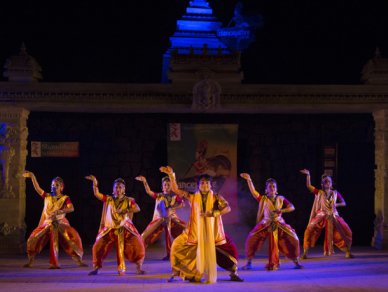 Jaydeep Palit & group Jaydeep Palit, the artistic director of Hrital, was introduced to the Uday Shankar style of free movement by the legendary Amala Shankar. For the purpose of stylizing his movements he has taken lessons in Kathakali from Guru Govindan Kutty. He commenced with the shloka "Sarve Shyam Mangalam Bhavatu." He performed 'Kartikeya,' a landmark piece in the history of Indian dance, to pay his tribute to Uday Shankar, whose use of softened Kathakali into graceful curves was rendered by Jaydeep successfully. The last piece choreographed and danced with his group was "Sajani sajani Radhika lo dekh abhuun chahiha" from Rabindranath Tagore's 'Bhanu Singher Padabali.' It was a romantic piece between Krishna, Radha and gopis with shringara rasa as the sthayi bhava. The piece had the sparkle and verve of the loving couple - a purna avatar and a human being. 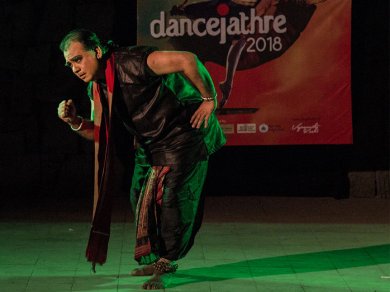 Ratikant Mohapatra The Srjan troupe performed 'Synthesis' and 'Ardhanariswar', while Guru Ratikant Mohapatra presented 'Sabari.' In Synthesis, Ratikant Mohapatra's choreography coalesced both intellectual and emotional content into a composite whole. It was a visual treat as the dancers synchronized with great precision. Ardhanariswar has been choreographed keeping in mind the elements of dance, drama and movement. The concept of Shiva and Parvati existing as an inseparable unit was intelligently brought about in a group performance. Though performed several times, the piece renews itself to the viewer by its sheer beauty. The story of Sabari, Rama's devotee who waiting for her 'ishtadevata' became a shrivelled frame of herself with the coming of old age was poignantly told. The soul remains ever young was the concept. Ratikant Mohapatra's depiction of Sabari was masterful, displaying all her emotions sensitively. 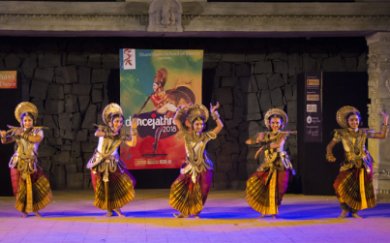 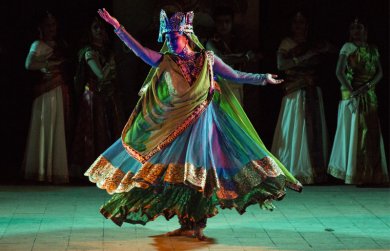 Fashion show A fashion show of dance costumes by upcoming dancers was an innovative inclusion. The participants were all dancers of the different dance genres who showed off their imaginative skills, while at the same time adhering to what the canons provided for them. 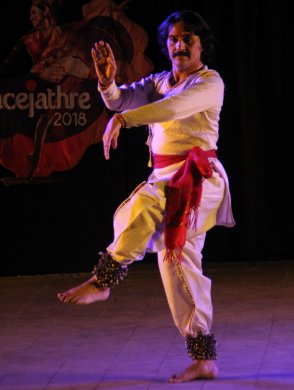 Pt. Rajendra Gangani Pt. Rajendra Gangani, son of the great guru and doyen Kundan Lal Gangani, known as the technical wizard of the Jaipur gharana of Kathak, was the first performer of the second evening. He opened with the Panchakshara Stotram to Lord Shiva, leaving the stage to his disciples to show the intricacies of taal dhamar, which is a musical type of taal of 14 beats, performing numerous permutations and combinations, before performing a scintillating tarana. 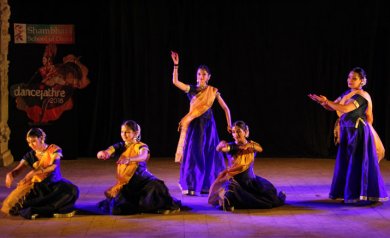 Pt. Rajendra Gangani's group They then led the audience to Hari Darshan with the line "Jay Jagdisha Hare." Several well known episodes from the life of Makhan chor was touched upon like adept kathakars. As charioteer in the battle of Kurukshetra, he gave 'Gita Gyan' to Arjuna and awed him with his viswaroopa darshan. 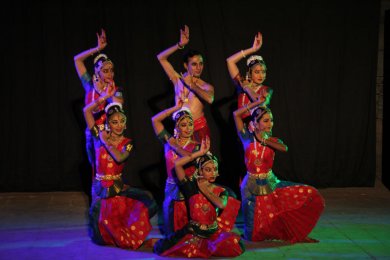 Praveen Kumar & group Bharatanatyam dancer Praveen Kumar who had been trained under late Guru Narmada earlier and is presently under the tutelage of Prof. C.V. Chandrasekhar started with Devarnama, encompassing two stories from the life of Sri Krishna, "Jagan Mohanane Krishna" by Purandara Dasa. Clad in peacock blue costume, Krishna and the gopis play a game of ball. A very expressive looking Yashoda came looking for Krishna and was aghast to find her little boy not only smeared with the mud with which he is playing, but has a mouthful of mud. But more awaited her. As he opens his mouth, she had a glimpse of the entire universe in his mouth. Her amazement knew no bounds. The next episode chosen was when Vishnu takes Vamana rupa and appears before the arrogant king Mahabali, asks for land enough to take three steps and amazed the king by covering the entire universe with one step and the entire space with the second and asked for space to take his third step. The humbled king had no option but to ask him to place his third step on his head. Depiction of the two episodes in chaste Bharatanatyam left the audience mesmerized. Shiva Stuti "Tha thai yena aaduvar" in raag Sindhu Bhairavi of Gopala Krishna Bharati described the magnificence of the cosmic dancer Nataraja. Vishnu and Brahma, the other two gods, were quick to realize that none but Shiva was the supreme god. The lightning like movements of Praveen's disciples, changing the stage design every now and then, was remarkable. Kuntalavarali Tillana of Balamurali Krishna was another gem by Praveen Kumar and his disciples. It gave the effect of numerous sparklers being lit at the same time. The group received a standing ovation. 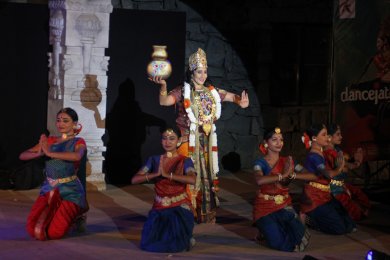 Vyjayanthi Kashi & group Vyjayanthi Kashi presented her spectacular dance drama 'Dharmaayana' bringing the festival to a fitting end. Just three days short of a full moon night, the audience feasted their eyes on Vyjayanthi in the anantasayana pose of Vishnu in the open air upper tier of the performance space, when the Suras disturbed by the Asuras for not allowing them to proceed with their Yajna, went right up to Vishnu. The audience was spellbound. The story of Samudra Manthan - the churning of the milky ocean - ordered by Vishnu, was a dramatic representation through dance of what happened during the event. Vasuki the snake, used as the rope and Mt. Mandar used as the churning stick was dramatically displayed. The spewing of poison from the milky ocean enveloped the world, saved in time by Shiva who drank it all up. When amrita came out, the Asuras and the Devas fought for it, only to be saved by Vishnu, who came in the form of Mohini, the enchantress, and managed to take it from the asuras and give it to the gods. Vyjayanthi Kashi had the audience in raptures and they wanted more of it. The festival in general and 'Dharmaayana' in particular was a success story. Dance Jathre is indeed a feather in the cap of Vyjayanthi Kashi. Tapati Chowdurie learnt dance from Guru Gopinath in his dance institution Natana Niketan in Madras. For a brief period, she was with International Centre for Kathakali in New Delhi. Tapati has a Master's degree in English Literature. Presently, she is a freelance writer on the performing arts. |